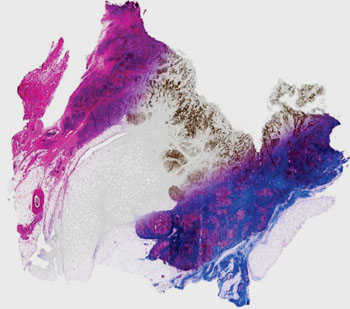New Technique Paints Tissue Samples with Light
By LabMedica International staff writers
Posted on 16 Apr 2015
One infrared scan can give pathologists a window into the structures and molecules inside tissues and cells, enabling fast and broad diagnostic assessments, due to a newly developed imaging technique.Posted on 16 Apr 2015
Doctors and scientist use stains or dyes that stick to the particular structure or molecule they are looking for when studying tissue samples. Staining can be a long and exacting process, and the added chemicals can damage cells. Histologists also have to choose which things to test for, because it is not always possible to obtain multiple samples for multiple stains from one biopsy. Dyes such as hematoxylin and eosin (H&E) and immunohistochemical stains have been increasingly used to visualize tissue composition in clinical practice.

Image: Breast tissue computationally stained using data from infrared imaging without actually staining the tissue, enabling multiple stains on the same sample. From left, the image shows a Hematoxylin and Eosin stain (pink-blue), molecular staining for epithelial cells (brown color) and Masson\'s trichrome (blue, red at right) (Photo courtesy of Prof. Rohit Bhargava).
Scientists at the University of Illinois Cancer Center (Urbana, IL, USA) and their colleagues have developed a technique using a combination of advanced microscope imaging and computer analysis. The new, advanced infrared imaging technique uses no chemical stains, instead scanning the sample with infrared light to directly measure the chemical composition of the cells. The computer then translates spectral information from the microscope into chemical stain patterns, without the bother of applying dyes to the cells.
The Fourier transform infrared (FT-IR) spectroscopic imaging and computation and stainless computed histopathology can enable a rapid, digital, quantitative and non-perturbing visualization of morphology and multiple molecular epitopes simultaneously in a variety of clinical pathology applications. The investigators reproduced a wide array of molecular stains by computationally isolating the spectra of specific molecules. This allows the user to simply tune to a required stain, for as many different stains as are necessary, all without damaging the original tissue sample, which can then be used for other tests.
David Mayerich, PhD, the lead author of the study, said, “We are relying on the chemistry to generate the ground truth and act as the 'supervisor' for a supervised learning algorithm. One of the bottlenecks in automated pathology is the extensive processing that must be applied to stained images to correct for staining artifacts and inconsistencies. The ability to apply stains uniformly across multiple samples could make these initial image processing steps significantly easier and more robust.” The study was published on March 20, 2015, in the journal Technology.
Related Links:
University of Illinois Cancer Center













